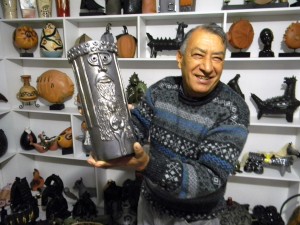Ancient themes and skilled artists and artisans make Ecuador an art collector’s paradise
By David Morrill
One of the great pleasures that many expats discover in Ecuador is art collecting. Even those who were not collectors back home take up the habit, smitten by the quality, variety, and sheer emotional force of the talent in this small Andean country. Another inducement is that good Ecuadorian art is remarkably inexpensive.

Guayasamin is Ecuador’s most famous modern artist.
Although collectors of paintings, sculptures, ceramics and carvings will find high-quality work in all parts of the country, the best place to look is in the Andes. Sometimes referred to as the Andean Craft Trail, the route from the Chota Valley and Ibarra in the north, to Cuenca in the south, offers an artistic treasure trove for those willing to put in the leg work. That bounty represent thousands of years of history and a rich legacy of tradition.
Ecuador’s modern artistic tradition began with the Spanish in the early 16th century, and the country quickly became the arts center of colonial Latin America. What became known as the Quito School and, later, the Cuenca School, were founded by Spanish priests and missionaries, using native artisans to produce religious paintings and sculpture. Although the schools’ early works were mostly European recreations, the Spanish soon recognized the artistry of indigenous imagery and techniques and these became widely incorporated into Ecuadorian artwork by the beginning of 17th century.

Eduardo Kingman was a contemporary of Guayasamin.
The great Ecuadorian painters of the 20th century, including Oswaldo Guayasamín, Eduardo Kingman and Endara Crow, continued to draw on indigenous as well as European themes, their work often expressing the tensions between the two cultures. The tradition of cultural conflict continues to be motivating force in the arts today.
Writing in the German newspaper Der Spiegel in 2014, German art critic Otto Kirchner was captivated by the vitality of Ecuadorian themes: “In Europe and North America, most artists turn inward for their imagery and the work tends to be psychological, dark, and often boring. Ecuadorian themes are vital and dynamic, drawing on deeply felt cultural conflict that continues today.”
In Ecuador to review Cuenca’s art bienal, Kirchner wrote: “Browsing the galleries in Quito and Cuenca I am struck not only by the exceptional quality but also by the low prices. Here, collectors can purchase works at a fraction of what they would pay for comparable work in Europe.”

Cuenca’s Eduardo Segovia in his ceramics studio.
Although you’ll find high-quality art in all parts of Ecuador, Quito, Cuenca, and Guayaquil probably offer the best concentration of galleries, exhibitions, and art festivals. Many galleries are located in tourist areas.
Several contemporary Ecuadorian artists worth checking out are Oswaldo Viteri and Ana Isabel Bustamante in Quito and Ignacio Silva in Guayaquil. In Cuenca, Edgar Carrasco, known for his work on copper, has built the strongest international reputation among local artists but others, including Alejandro Beltran, Ricardo Montesinos, Ariel Dawi and Alberto Soriano are also widely known.
Eduardo Segovia and Eduardo Vega, both of Cuenca, are Ecuador’s most celebrated ceramicists and have exhibited in Europe as well as other Latin America countries. Segovia was the subject of a popular European documentary several years ago, showcasing his spirited teaching methods with a group of Dutch sculptors.

Guitar-making in San Bartolome.
For the collector of high-end crafts, Ecuador offers a similar treasure trove — and more bargains. Among the offerings are pottery, musical instruments, woodcarvings, jewelry, ceremonial masks, religious icons, and textiles.
Small towns outside of Quito and Cuenca are fertile hunting grounds for the craft collector. In Otavalo, an hour’s drive north of Quito, you’ll find a variety of carved, ceramic, woven, and painted crafts. Cotacachi, just outside of Otavalo, is known for its polychromed religious statuary that uses centuries-old finishing techniques. Farther north, around the central square of San Antonio de Ibarra, you’ll find shops selling museum-quality woodcarvings. Just south of the Colombian border, the richly detailed ceramic masks made by descendants of African slaves are also attracting international attention — and buyers.

Ikat weavings are popular with collectors.
Cuenca and surrounding towns provide a mother lode of exceptional crafts. You’ll find metal and ceramic sculpture, hand-made dinnerware, and Panama hats in Cuenca; ikat fabric art in Gualaceao; silver and gold filigree sculpture and jewelry in Chordeleg; and ceramics and musical instruments in Sig Sig and San Bartolome.
The same rules apply to an Ecuadorian art collection as to any other. Put in the legwork and research to make sure you know what you’re buying, and, if you are buying a recognized, more expensive artist, make sure you’re getting the real thing and ask for a certificate of authenticity. Concentrate on a style and time period. If you’re more ambitious, consider making yours a true Andean collection, and include work from Peru, Bolivia and Colombia as well as Ecuador.
Most of all, buy what you like. You’ll find plenty to choose from in Ecuador.





















